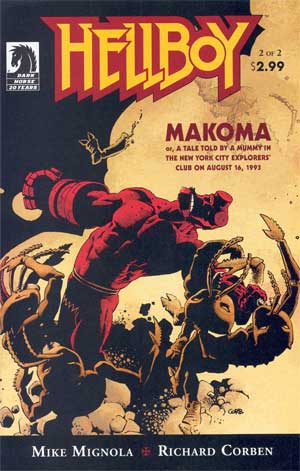Hellboy: Makoma #1 - #2
By Al Kratina
March 9, 2006 - 13:54
Dark Horse Comics
Writer(s): MIKE MIGNOLA
Penciller(s): MIKE MIGNOLA/RICHARD CORBEN
Cover Artist(s): RICHARD CORBEN and DAVE STEWART
 |
| Hellboy Vs. Them |
I love Hellboy. But I love Hellboy for the same reasons that I love my old Venom LPs, because they're so very familiar. I know every note and every word, and even if I didn’t, I could probably make a fairly good guess as to what’s coming next. With Venom, one can pretty much expect a punky four-chord Motorhead riff and a bunch of growling about either battleaxes or Satan. With Dark Horse Comics’ signature character Hellboy, it’s safe to assume every story will involve H.P. Lovecraft references, Eastern Europe, and a giant monster getting punched to death. The twist in recent stories relocates the action to Africa, but much of the punching remains intact, so I’m not too shaken up by it. Still, it would be nice if things changed every once in a while, just to keep from getting stale.
And, thankfully, they do. The latest Hellboy story, the two issue mini-series Makoma, has the distinction not only of being set in Africa, but of being the first Hellboy story not to be illustrated solely by Mike Mignola. Instead, much of the art duties are handled by Richard Corben, a fine artist who has the distinctive talent of making every character look like Puck from Alpha Flight. But despite his predilection for squat, muscular characters, Corben is right at home in the Hellboy mythos, adapting his own style to Mignola’s world of predominant pitch blacks and angular lines. While it’s odd to see Hellboy not look like Hellboy, it just makes everything in the book seem all the stranger, a welcome addition to any supernatural comic.
As for the story, while it doesn’t let readers in on what’s been happening to Hellboy since his recent disappearance in Africa, it does contribute something to the overarching mythos. Set in 1993, the majority of the comic is a story narrated to Hellboy by a mummy in the New York City Explorers' Club. The New York portion of the comic, essentially a bookend, is drawn by Mignola, but in order to differentiate fantasy from reality the mummy’s tale itself is illustrated by Corben. The story the mummy tells is the ancient African folktale of Makoma, a powerful boy with a hammer and sack who spends much of his life beating giants to death. So, it's pretty much perfect for the comic, and the character of Hellboy is fittingly substituted for Makoma. The story sticks fairly closely to the original oral narrative, though there’s a few more killer ant-men than I remember from my university folklore classes. While this miniseries, being essentially a flashback, doesn’t move things forward in the grand scheme of things, the ending of the tale, which features a confrontation between Hellboy/Makoma and a many-headed dragon, has clear parallels with Hellboy’s past, and apparently his future. Written in Mignola’s well-practiced minimalist and lightly humorous style, the comic departs just enough from the Hellboy formula to make the story arc familiar without, thankfully, breeding contempt.
Related Articles:
Dark Horse Announces New Hellboy Graphic Novel
Hellboy: The Fury #3 Review
Hellboy Returns to Dark Horse Presents
Hellboy: The Fury #3 Sells Out
Hellboy: The Fury #2 Review
Hellboy Creator Mike Mignola Coming to Calgary Comic and Entertainment Expo
Dark Horse Comics Announces Hellboy on iPhone
Hellboy II: The Golden Army
Hellboy 2 DVD Launch Party
Give 'em Hellboy II: The Golden Army
